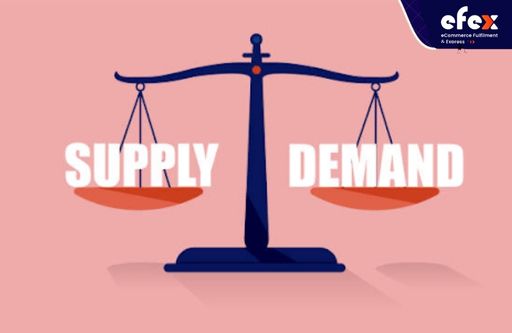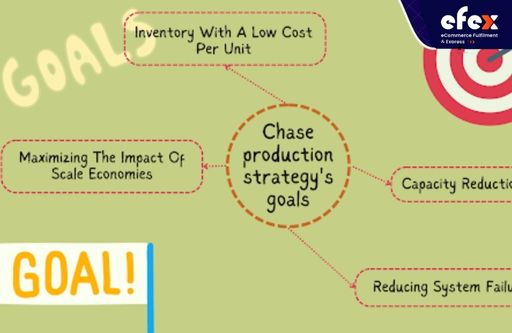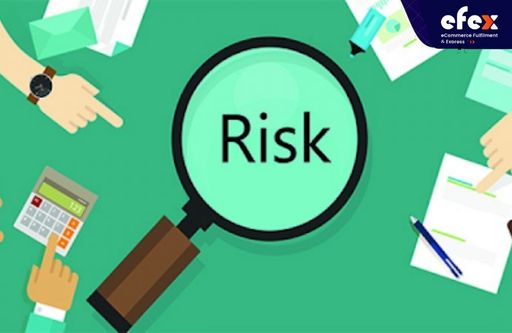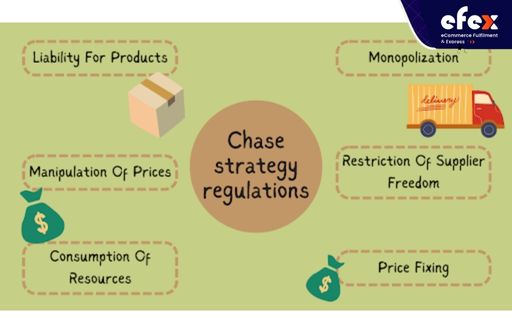
More Helpful Content
Inability to fulfill orders may destroy consumer trust, but keeping too much inventory on hand is problematic for a variety of reasons. As a result, it is essential to analyze the many tactics available for production planning and management and select the one that will be most helpful to you.
In this article, we will introduce to you one of the most popular planning and management tactics that you may adopt in your manufacturing business, which is the chase production strategy. It is a simple yet efficient method for planning your manufacturing and avoiding stockouts problems.

When you see the term “chase”, you can easily picture how this manufacturing approach works. A manufacturing line moves rapidly with the products required, and personnel is close by, able to adapt quickly to several client orders that are coming in.
So, what is the chase production strategy? The chase production strategy which is also known as the “Demand matching” strategy is a method of planning your output and avoiding stock-outs.
The main principle is to monitor consumer demand and create enough items to fulfill demand while allowing for inventory. It is appropriate for seasonal things.
👉 Read More: What Is Level Production Strategy? Example And Formula

The concept of chasing market demand is referred to as the chase strategy. Production is geared to match demand, with no surplus items. It is a lean production technique that saves money until the demand or the order is met.
Besides, it is suitable for seasonal products since the demand for these commodities is known in advance. Manufacturing can be adapted to meet these requirements.
The Chase strategy depends on the market demands, thus, it is critical to be adaptable and ready to change in response to the changing market needs.
The chase production approach is motivated by two following factors. The first factor is product differentiation and specialized markets. It is typical when there are several product variants and specialty markets.
Buyer orders must be filled, and their precise order must be produced. The second one is consumable goods. These products have an extremely limited market. These things have a market that is always looking for something fresh. These items are vulnerable to new competitors.
Similar to other strategies, the chase strategy also has distinct objectives. So, what are the strategies and objectives?

The total number of units lost is maintained to a minimum. Since inventory is kept to a low, it is simpler to keep track of inventory costs and cost inaccuracies.
It relates to making the best use of all industrial resources. For instance, if there are extra workers, just the necessary people are employed. Similarly, if there are costly industrial types of equipment, they must be used as efficiently as possible.
This is the notion that industrial capacity should never be greater than the real demand for products. It is accomplished by maintaining stock at a low and ensuring that production capacity is adaptable enough just to meet market needs.
It shows that if there are bottlenecks in the manufacturing systems, the product will be delivered to the client later. This causes the payment and profit connected with the goods to be delayed.
Here are a few risks to employing the chase strategy that you should concern about.

Market fluctuations can be foreseen. When the demand decreases, the chasing method might be dangerous due to the slow manufacturing and dropped prices.
When large or unanticipated quantities of orders arrive, the chase method might be problematic since the rapid changes will impede production and delivery. More modifications will have to be made quickly by the manufacturer.
Inventory risks can be ignored or underestimated and it will lead to danger when there is an excessive amount of inventory or inventory used incorrectly.
There are some other risks of the chase strategy along with the above risks that you should know. They include the oversight of all parts of the business, unanticipated production expenses, overestimation or underestimation of market demand, and the dangers of altering client behavior.
The chase approach is a popular strategy, particularly when going with other manufacturing strategies. Other solutions offer more flexibility in the manufacturing schedule, enabling adjustments in orders, pricing fluctuations, and market demands.
The pursuit tactic relies heavily on flexibility. According to academic research, a chase strategy is the most successful only when the manufacturing line is adaptable to its specific changes. You can take a look at a company that manufactures swimming pool liners as an illustration of a chase strategy.
The need for pool liners varies based on the season, but manufacturing must be sufficiently flexible to accommodate these variations. Both production and sales have to be prepared for changes in the market.
👉 Read More: What Is Acceptable Quality Level? Formula And Example

People who advocate the pursuit method claim that it is crucial for generating high-quality things. This is due to the fact that the manufacturing line is managed to keep quick and effective.
There are as few stages as feasible in the process, as well as the things are offered at a lesser price.
Close connection with the consumer is essential for the chase strategy. All orders and requests must be communicated to the consumer in advance. It is critical to understand who the consumer is and as well as what do they want.
The chasing technique works well for seasonal products but not so well for other things. For the seasonal products, the producer may plan in advance and have enough production capacity to meet demand.
But, demand does not necessarily correlate to supply. Production must be adaptable and move in the direction of demand.
The pursuit tactic is a little more complicated. the manufacturing and sales teams collaborate closely, which causes a lot of issues. In many cases, the chase approach is inappropriate.
However, when used correctly, it is a tremendously successful method. The chase approach is often utilized in sectors where output and sales levels are continually changing. the capacity to accommodate changing market needs and changes is the most vital sign of a “chase” approach.

The chase production strategy can be modified in several ways, including:

Here are some advantages that your business can get when applying this strategy.

There is no perfect strategy. No matter how well the chase strategy can help your business, it still has some disadvantages that you should concern about.
The chase production strategy is not directly regulated. However, there are several rules associated with the chasing strategy, including:

Concerns about safety and quality are closely tied to the chasing tactic. Poor quality management, lack of mitigation actions, and a reduction in safety precautions all have the potential to result in product liability.
The market can be drastically affected since the chasing strategy is a price strategy. The chase tactic is related to price fixing, market manipulation, and other predatory pricing tactics.
Price fixing is inherent in the chasing tactic. It can distort the market, therefore, authorities may need to intervene.
In reality, the chase strategy leads to the monopolization of the market due to the increasing and decreasing levels of output.
Whenever it comes to pursuit techniques, suppliers have very limited leeway and are frequently restricted by a variety of unethical practices.
The monopoly of chasing methods can have negative consequences for the Earth, like pollution and resource exhaustion.
You can consult a company that manufactures and sells shirts as an example of adopting the chase strategy. In this case, the corporation wishes to manufacture 5,000 shirts every month.
However, they must determine client demand first. They will keep track of how many shirts they sell and when they sell these shirts. The company discovers that it sells 500 shirts every week on average.
👉 Read More: What Is Landed Cost: Meaning And How To Calculate It
Depending on this data, it creates 600 shirts every week to fulfill consumer demand while still leaving extra space for inventory. The company will change output as necessary in the following month to meet client demand.
They can expand output as demand rises or reduce output as demand falls. By doing this, they can prevent stockouts and always have an adequate quantity of shirts to match client demand.
👉 Read More: What Is Universal Product Code And How To Get It
The chase production strategy is frequent in sectors where perishables are a concern, or in businesses that do not have a significant amount of additional cash on hand and do not want to face loss, unsold items, or theft.
Moreover, it can be employed efficiently when combined with other production tactics.
However, whether the chase strategy is appropriate for your company will be determined by a variety of criteria, including your industry and operational conditions.


